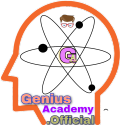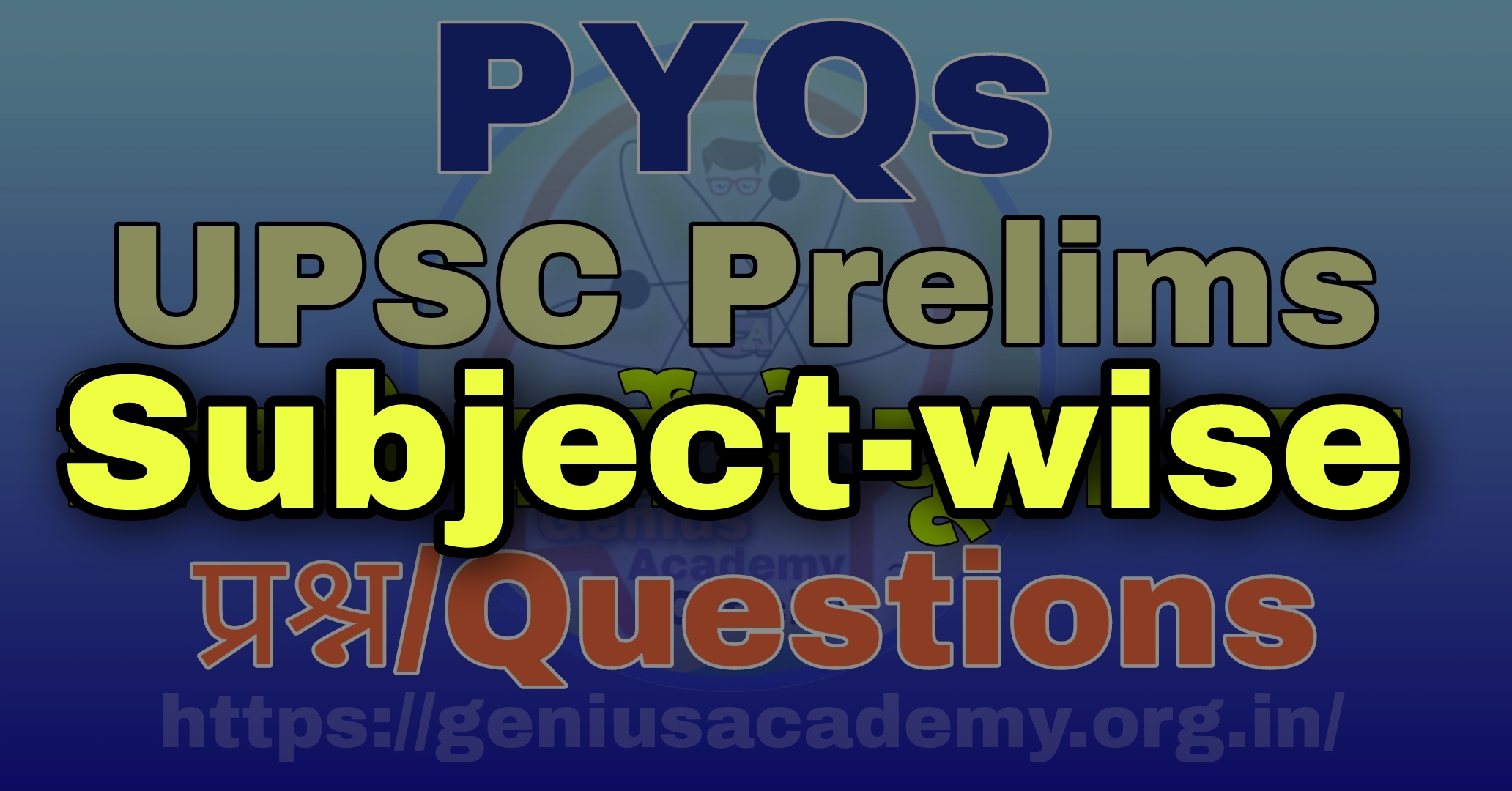UPSC Prelims PYQs Subject-wise
| Arts & Culture – UPSC CSE Preliminary (PYQs) |
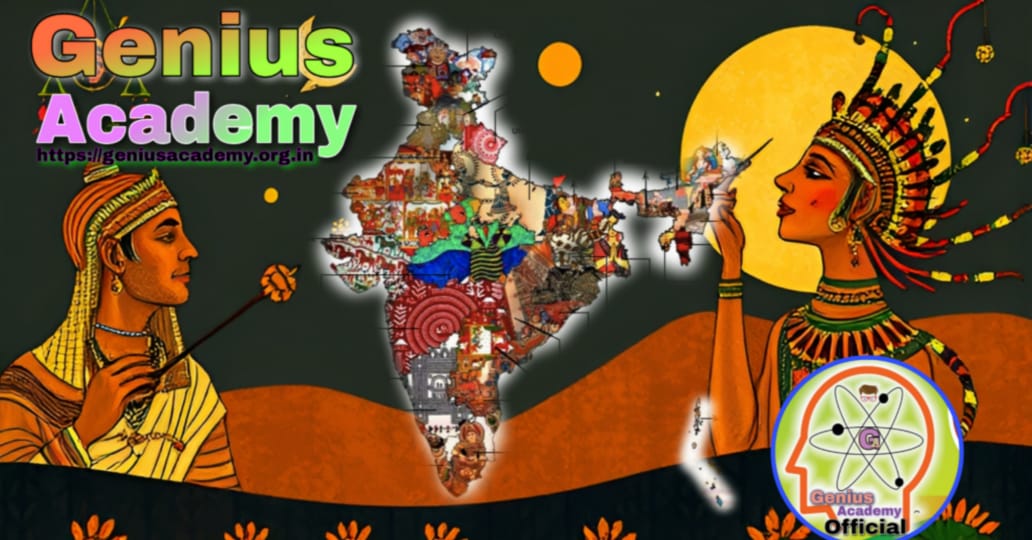
13. Consider the following towns of India:
1. Bhadrachalam
2. Chanderi
3. Kancheepuram
4. Karnal
Which of the above are famous for the production of traditional sarees/fabric?
Thus, only Chanderi (2) and Kancheepuram (3) are famous for traditional sarees/fabric, making option (b) the right answer.
14. In the context of cultural history of India, a pose in dance and dramatics called ‘Tribhanga’ has been a favourite of Indian artists from ancient times till today.
Which one of the following statements best describes this pose?
(a) One leg is bent and the body is slightly but oppositely curved at waist and neck
(b) Racial expressions, hand gestures and make-up are combined to symbolize certain epic or historic characters
(c) Movements of body, face and hands are used to express oneself or to tell a story
(d) A little smile, slightly curved waist and certain hand gestures are emphasized to express the feelings of love or eroticism
Correct Answer!
Incorrect Answer!
The correct answer is (a) One leg is bent and the body is slightly but oppositely curved at waist and neck
Tribhanga (meaning “three bends” in Sanskrit) is a classical pose in Indian dance and sculpture, characterized by the body being bent at three points: the knees, waist, and neck, with one leg bent and the body curved in opposite directions at the waist and neck. This creates an elegant, S-shaped posture, often seen in ancient Indian sculptures (e.g., in temples like Khajuraho or Konark) and classical dances like **Odissi*. It symbolizes grace and fluidity and has been a favorite of Indian artists from ancient times to the present. This description matches option (a).
Option (b): Refers to abhinaya (expressive elements) in Indian dance, involving facial expressions, hand gestures (mudras), and makeup to depict characters, not Tribhanga.
Option (c): Describes general dance movements or nritta/natya (pure dance or storytelling), not the specific Tribhanga pose.
Option (d): While Tribhanga can convey emotions like love or eroticism in certain contexts (e.g., in Krishna-Radha depictions), it is primarily a physical pose, not defined by a smile or specific hand gestures.
Thus, (a) best describes the Tribhanga pose.
15. With reference to Dhrupad, one of the major traditions of India that has been kept alive for centuries, which of the following statements are correct?
1. Dhrupad originated and developed in the Rajput Kingdom period.
2. Dhrupad is primarily a devotional and spiritual music.
3. Dhrupad Alap uses Sanskrit syllables from Mantras.
Select the correct answer using the codes below:
(a) 1 and 2 only
(b) 2 and 3 only
(c) 1, 2 and 3 only
(d) None is correct
Correct Answer!
Incorrect Answer!
The correct answer is (b) 2 and 3 only
Statement 1: Dhrupad originated and developed in the Rajput Kingdom period.
Dhrupad, one of the oldest forms of Hindustani classical music, is believed to have originated in the medieval period, particularly during the 15th–16th centuries, under the patronage of rulers like Raja Man Singh Tomar of Gwalior, not specifically during the Rajput Kingdom period (which is a broader and earlier historical context). It was formalized in the courts of Gwalior and later flourished under Mughal patronage. The statement is misleading and not entirely accurate, as Dhrupad’s development is more closely tied to the Bhakti movement and courtly traditions than the Rajput Kingdom period alone. This statement is incorrect.
Statement 2: Dhrupad is primarily a devotional and spiritual music.
Dhrupad is deeply rooted in devotional and spiritual themes, often performed in praise of deities like Lord Krishna, Shiva, or other divine figures. Its compositions, known as dhrupads, frequently draw from Bhakti and spiritual traditions, and it was historically performed in temples and courts to evoke a meditative and divine experience. This statement is correct.
Statement 3: Dhrupad Alap uses Sanskrit syllables from Mantras.
In Dhrupad, the Alap (the introductory, non-rhythmic portion of the performance) often uses syllables like “re, na, ta, ri” derived from Sanskrit mantras or Vedic chants. These syllables, known as nom-tom, are sung in a free-flowing, meditative style to explore the raga’s essence. This practice is a distinctive feature of Dhrupad, setting it apart from other classical music forms like Khayal. This statement is correct.
Thus, only statements 2 and 3 are correct, making option (b) the right answer.
16. How do you distinguish between Kuchipudi and Bharatanatyam dances?
1. Dancers occasionally speaking dialogues is found in Kuchipudi dance but not in Bharatanatyam.
2. Dancing on the brass plate by keeping the feet on its edges is a feature of Bharatanatyam but Kuchipudi dance does not have such a form of movements.
Which of the statements given above is/are Correct?
(a) Only 1
(b) Only 2
(c) Both 1 and 2
(d) Neither 1 nor 2
Correct Answer!
Incorrect Answer!
The correct answer is (a) Only 1
Statement 1: Dancers occasionally speaking dialogues is found in Kuchipudi dance but not in Bharatanatyam.
Kuchipudi, a classical dance form from Andhra Pradesh, is known for its dance-drama tradition, where dancers may occasionally speak dialogues or sing as part of the performance, especially in narrative pieces derived from its historical roots in Natya (theatrical storytelling). Bharatanatyam, originating from Tamil Nadu, focuses on pure dance (nritta) and expressive gestures (nritya) without spoken dialogues, relying on facial expressions and mudras to convey the narrative. This distinction is accurate, making this statement correct.
Statement 2: Dancing on the brass plate by keeping the feet on its edges is a feature of Bharatanatyam but Kuchipudi dance does not have such a form of movements.
Dancing on a brass plate (known as *Tarangam) is a unique feature of **Kuchipudi, not Bharatanatyam. In Kuchipudi, dancers demonstrate their skill by balancing on the edges of a brass plate while performing intricate footwork, often accompanied by rhythmic patterns. Bharatanatyam does not include this practice, focusing instead on precise footwork and postures on the floor. The statement incorrectly attributes this feature to Bharatanatyam, making it incorrect.
Thus, only Statement 1 is correct, making option (a) the right answer.
Dance
Related State
Description
Bharatanatyam
Tamil Nadu
A traditional South Indian dance form known for its intricate footwork, graceful expressions (abhinaya), and devotional storytelling often based on Hindu epics and temple traditions.
Kathak
Uttar Pradesh
A North Indian classical dance characterized by swift spins (chakkars), rhythmic foot movements, and expressive storytelling (katha) rooted in Mughal and Bhakti traditions.
Kathakali
Kerala
A dramatic classical dance-theatre featuring elaborate face makeup, ornate costumes, and storytelling through symbolic hand gestures (mudras) and facial expressions (rasas), often portraying mythological tales.
Kuchipudi
Andhra Pradesh
A dance-drama style combining pure dance (Nritta), expressional dance (Nritya), and dramatic representation (Natya), often involving character portrayal and use of dialogues or songs.
Odissi
Odisha
Known for its lyrical grace, tribhanga posture, and devotional mood, Odissi often narrates stories of Lord Jagannath, showcasing temple sculpture-like poses and smooth body movements.
Sattriya
Assam
A monastic dance rooted in the Vaishnavite traditions of Assam, developed by Srimanta Sankardev; performed in satras with a focus on devotion, spirituality, and bhakti rasa.
Manipuri
Manipur
A serene and devotional dance form linked to the Raas Leela of Krishna and Radha, marked by flowing costumes, gentle hand movements, and spiritual storytelling.
Mohiniyattam
Kerala
Graceful solo dance form associated with the feminine aspect of divinity (Mohini), noted for its swaying movements, soft expressions, and emotive storytelling based on love and devotion.
Chhau
West Bengal, Jharkhand, Odisha
A martial-based semi-classical dance blending folk, tribal, and classical elements; features acrobatic movements, masked performances, and themes from epics and folk traditions.
17. The brothers Umakant and Ramakant Gundecha are:
(a) Dhurpad vocalists
(b) Kathak dancers
(c) Sarod Maestros
(d) Tabla players
Correct Answer!
Incorrect Answer!
The correct answer is (a) Dhurpad vocalists
The Gundecha Brothers, Umakant and Ramakant Gundecha, are renowned Dhrupad vocalists from Madhya Pradesh, India. They are celebrated for their mastery of Dhrupad, one of the oldest forms of Hindustani classical music, characterized by its devotional and meditative style. They have significantly contributed to preserving and promoting this ancient tradition through performances and teaching at the Dhrupad Sansthan in Bhopal.
Option (b) Kathak dancers: Kathak is a classical dance form, not associated with the Gundecha Brothers.
Option (c) Sarod Maestros: The sarod is a stringed instrument, and maestros like Amjad Ali Khan are known for it, not the Gundecha Brothers.
Option (d) Tabla players: Tabla players like Zakir Hussain are distinct from the vocalists Umakant and Ramakant Gundecha.
Thus, (a) correctly identifies the Gundecha Brothers as Dhrupad vocalists.
18. Consider the following famous name:
1. Amrita Sher-Gil
2. Bikash Bhattaeharjee
3. N. S. Bendre
4. Subodh Gupta
Who of the above is/are-well known as artist (s)?
(a) 1 only
(b) 2 and 4 only
(c) 2, 3 and 4 only
(d) 1, 2, 3 and 4
Correct Answer!
Incorrect Answer!
The correct answer is (d) 1, 2, 3 and 4
All four individuals listed are well-known artists from India, each contributing significantly to the field of visual arts in different styles and periods.
1. Amrita Sher-Gil: A pioneering modernist painter of the early 20th century, often called India’s Frida Kahlo. She is renowned for her vibrant portraits and paintings blending Indian and Western styles, such as *Three Girls and Village Scene. She is widely recognized as one of India’s most celebrated artists. Correct.
2. Bikash Bhattacharjee: A prominent Indian painter known for his surrealist and realist works, particularly his evocative portraits and socio-political commentaries. His paintings, like Doll Series and Durga, reflect deep emotional and societal themes. He is a well-known artist. Correct.
3. N. S. Bendre: A distinguished modernist artist and a key figure in the Progressive Artists’ Group. His works, characterized by vibrant colors and abstract forms, include landscapes and figurative paintings. He played a significant role in shaping modern Indian art. Correct.
4. Subodh Gupta: A contemporary Indian artist famous for his large-scale installations and sculptures using everyday objects like stainless steel utensils, reflecting Indian culture and globalization. Works like Very Hungry God have earned him international acclaim. He is a well-known artist. Correct.
Thus, all four—Amrita Sher-Gil, Bikash Bhattacharjee, N. S. Bendre, and Subodh Gupta—are well-known as artists, making option (d) the correct answer.
19. Consider the following statements:
1. The National School of Drama was set up by Sangeet Natak akademi in 1959.
2. The highest honour conferred by the Sahitya akademi on a writer is by electing him its Fellow.
Which of the statements given above is/are correct?
(a) Only 1
(b) Only 2
(c) Both 1 and 2
(d) Neither 1 nor 2
Correct Answer!
Incorrect Answer!
The correct answer is (c) Both 1 and 2
Statement 1: The National School of Drama was set up by Sangeet Natak Akademi in 1959.
The National School of Drama (NSD) was established in 1959 under the aegis of the Sangeet Natak Akademi, India’s national academy for music, dance, and drama. It was set up to promote and train professionals in theater and dramatic arts and became an autonomous institution in 1975. This statement is correct.
Statement 2: The highest honour conferred by the Sahitya Akademi on a writer is by electing him its Fellow.*
The Sahitya Akademi, India’s national academy of letters, confers its highest honor, the Sahitya Akademi Fellowship, on distinguished writers for their outstanding contributions to literature. This is considered more prestigious than the Sahitya Akademi Award, as it recognizes lifetime achievement and is limited to a small number of living fellows at any time. This statement is correct.
Thus, both statements 1 and 2 are correct, making option (c) the right answer.
20. Match List I with List II and select the correct answer using the code given below the lists:
List-I
(Famous Person)
List-II
(Well-known for)
A. Mandakini Amte
1. Theatre direction
B. Neelam Mansingh Chowdhry
2. Social Service and Community leadership
C. Romila Thaper
3. Dance
D. Vanashree Rao
4. History writing
Code: A B C D
(a) 2 1 4 3
(b) 2 4 1 3
(c) 3 1 4 2
(d) 3 4 1 2
Correct Answer!
Incorrect Answer!
The correct answer is (a) 2 1 4 3
A. Mandakini Amte – 2. Social Service and Community Leadership
Mandakini Amte, along with her husband Prakash Amte, is renowned for her social service and community leadership, particularly through their work at Lok Biradari Prakalp in Maharashtra. They have dedicated their lives to providing healthcare, education, and sustainable development to tribal communities in Gadchiroli, earning accolades like the Magsaysay Award. This matches Social Service and Community Leadership. (www.data.gov.in)
B. Neelam Mansingh Chowdhry – 1. Theatre Direction
Neelam Mansingh Chowdhry is a celebrated theatre director based in Chandigarh, known for directing plays like Nagamandala, Hayavadana, and Kitchen Katha. She is a recipient of the Sangeet Natak Akademi Award (2003) and Padma Shri (2011) for her contributions to theatre. This matches Theatre Direction. (bharatpedia)
C. Romila Thapar – 4. History Writing
Romila Thapar is a distinguished Indian historian, acclaimed for her works on ancient Indian history, including books like A History of India and Asoka and the Decline of the Mauryas. Her scholarly contributions have made her a leading figure in history writing. This matches History Writing.
D. Vanashree Rao – 3. Dance
Vanashree Rao is a well-known exponent of Kuchipudi, a classical Indian dance form. She has performed extensively and is recognized for her artistry and choreography in this traditional dance style. This matches Dance.
Matching:
– A (Mandakini Amte) → 2 (Social Service and Community Leadership)
– B (Neelam Mansingh Chowdhry) → 1 (Theatre Direction)
– C (Romila Thapar) → 4 (History Writing)
– D (Vanashree Rao) → 3 (Dance)
Thus, the correct code is A B C D: 2 1 4 3, corresponding to option (a).
21. Consider the following pairs:
Tradition
State
1. Gatka, a traditional martial art:
Kerala
2. Madhubani, a traditional painting:
Bihar
3. Singhey Khababs Sindhu Darshan Festival:
Jammu & Kashmir
Which of the pairs given above is/are correctly matched?
(a) 1 and 2 only
(b) 3 only
(c) 2 and 3 only
(d) 1, 2 and 3
Correct Answer!
Incorrect Answer!
The correct answer is (c) 2 and 3 only
Pair 1: Gatka, a traditional martial art – Kerala
Gatka is a traditional Sikh martial art originating from Punjab, not Kerala. It involves the use of weapons like sticks and swords and is performed during festivals and cultural events. Kerala is known for its own martial art, Kalaripayattu. This pair is incorrect.
Pair 2: Madhubani, a traditional painting – Bihar
Madhubani painting, also known as Mithila art, is a traditional folk art form from *Bihar, characterized by intricate geometric patterns and mythological themes, often painted with natural dyes. This pair is correct.
Pair 3: Singhey Khababs Sindhu Darshan Festival – Jammu and Kashmir
The Singhey Khababs Sindhu Darshan Festival is celebrated in Jammu and Kashmir, particularly in Leh, Ladakh. It is a cultural festival held along the banks of the Indus (Sindhu) River, promoting unity and celebrating the river’s significance. This pair is correct.
Thus, only Pairs 2 and 3 are correctly matched, making option (c) the right answer.
22. Match List I with List II and select the correct answer using the code given below the lists:
List-I
(Famous Person)
List-II
(Well-known for)
A. Amrita Sher-Gil
1. Dancer
B. Bhimsen Joshi
2. Painter
C. Rukmini Devi Arundale
3. Poet
D. Suryakant Tripati Nirala
4. Singer
Code: A B C D
(a) 2 1 4 3
(b) 2 4 1 3
(c) 3 1 4 2
(d) 3 4 1 2
Correct Answer!
Incorrect Answer!
The correct answer is (b) 2 4 1 3
A. Amrita Sher-Gil – 2. Painter
Amrita Sher-Gil (1913–1941) was a pioneering Indian modernist painter, often referred to as India’s Frida Kahlo. Her works, such as Three Girls and Village Scene, blend Indian themes with Western techniques, making her one of India’s most celebrated artists. This matches Painter.
B. Bhimsen Joshi – 4. Singer
Pandit Bhimsen Joshi (1922–2011) was a legendary Hindustani classical singer, renowned for his mastery of the Kirana Gharana. His powerful renditions of ragas and bhajans earned him the Bharat Ratna (2008). This matches Singer.
C. Rukmini Devi Arundale – 1. Dancer
Rukmini Devi Arundale (1904–1986) was a pioneering dancer and choreographer, credited with reviving and popularizing Bharatanatyam. She founded the Kalakshetra Foundation in Chennai to promote classical dance and arts. This matches Dancer.
D. Suryakant Tripathi Nirala – 3. Poet
Suryakant Tripathi Nirala (1896–1961) was a prominent Hindi poet, writer, and essayist of the Chhayavaad movement. His works, like Saroj Smriti and Ram Ki Shakti Puja, are celebrated for their lyrical and philosophical depth. This matches Poet.
Matching:
– A (Amrita Sher-Gil) → 2 (Painter)
– B (Bhimsen Joshi) → 4 (Singer)
– C (Rukmini Devi Arundale) → 1 (Dancer)
– D (Suryakant Tripathi Nirala) → 3 (Poet)
Thus, the correct code is A B C D: 2 4 1 3, corresponding to option (b).
23. Bimbavati Devi is a well-known dancer of which type of dance?
(a) Manipuri
(b) Bharat Natyam
(c) Kuchipudi
(d) Odissi
Correct Answer!
Incorrect Answer!
The correct answer is (a) Manipuri
Bimbavati Devi is a renowned dancer and choreographer known for her expertise in Manipuri dance, a classical dance form from Manipur, India. She is the daughter of Guru Bipin Singh and Guru Kalavati Devi, both legendary figures in Manipuri dance. Bimbavati has contributed significantly to preserving and promoting this graceful and devotional dance form, characterized by fluid movements and Vaishnavite themes.
Thus, (a) Manipuri is the correct answer.
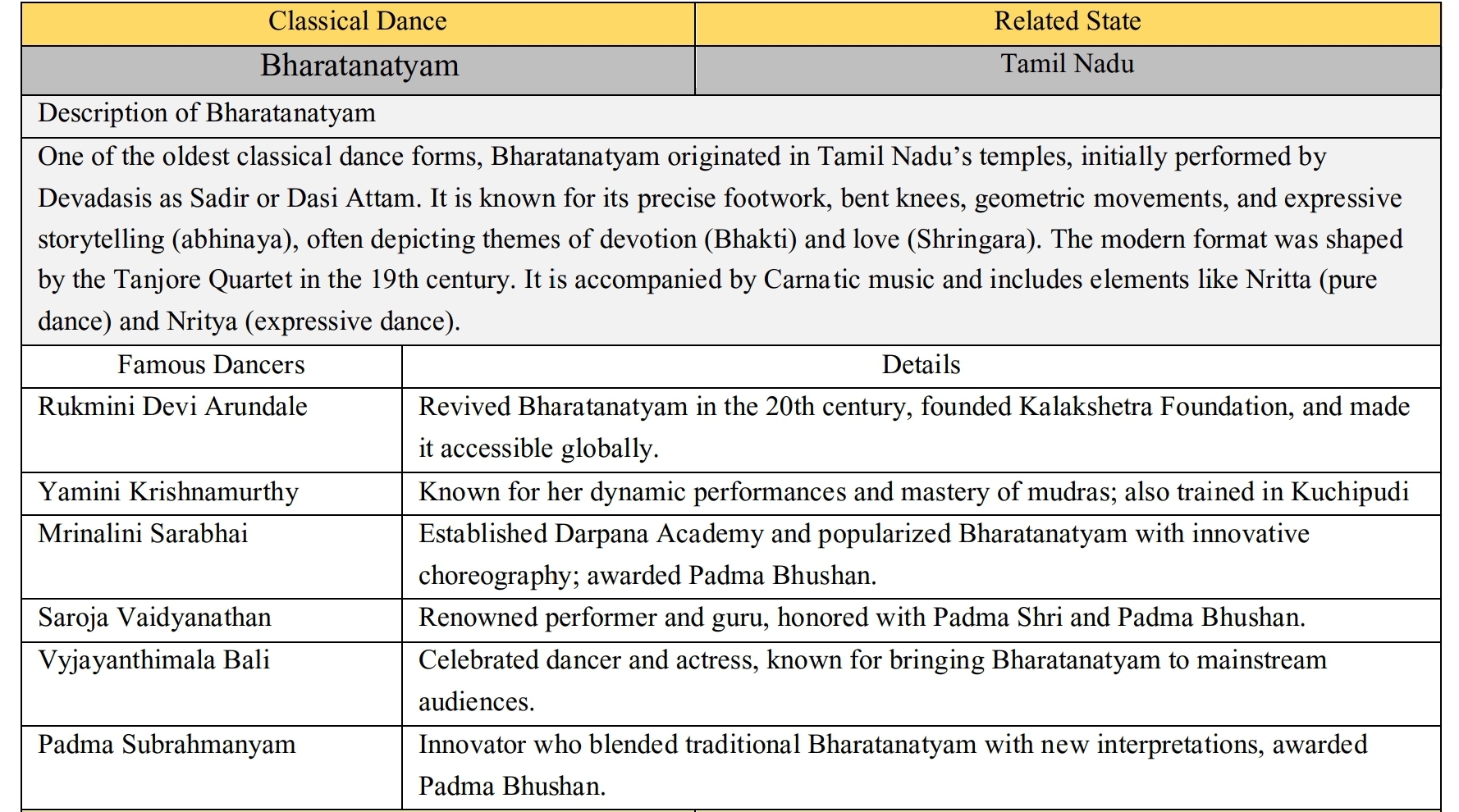
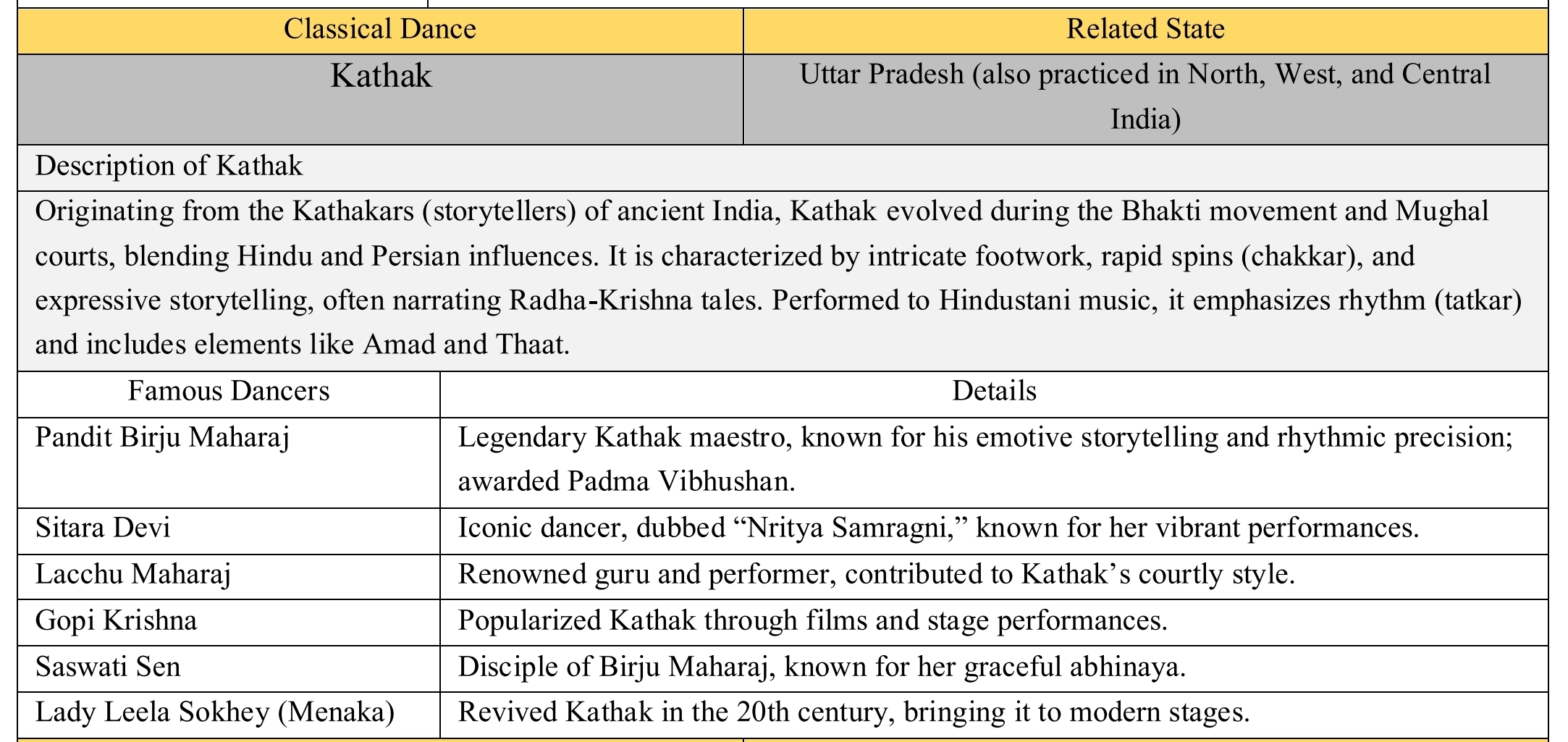
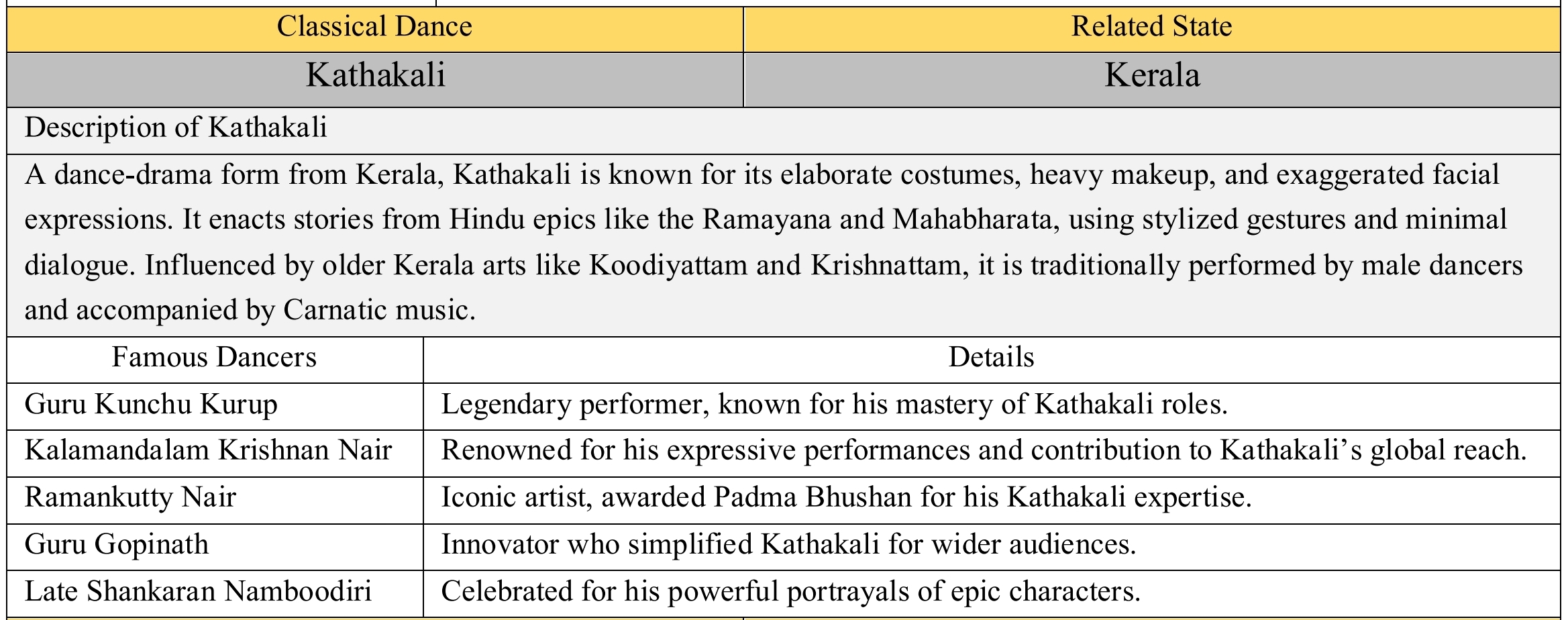
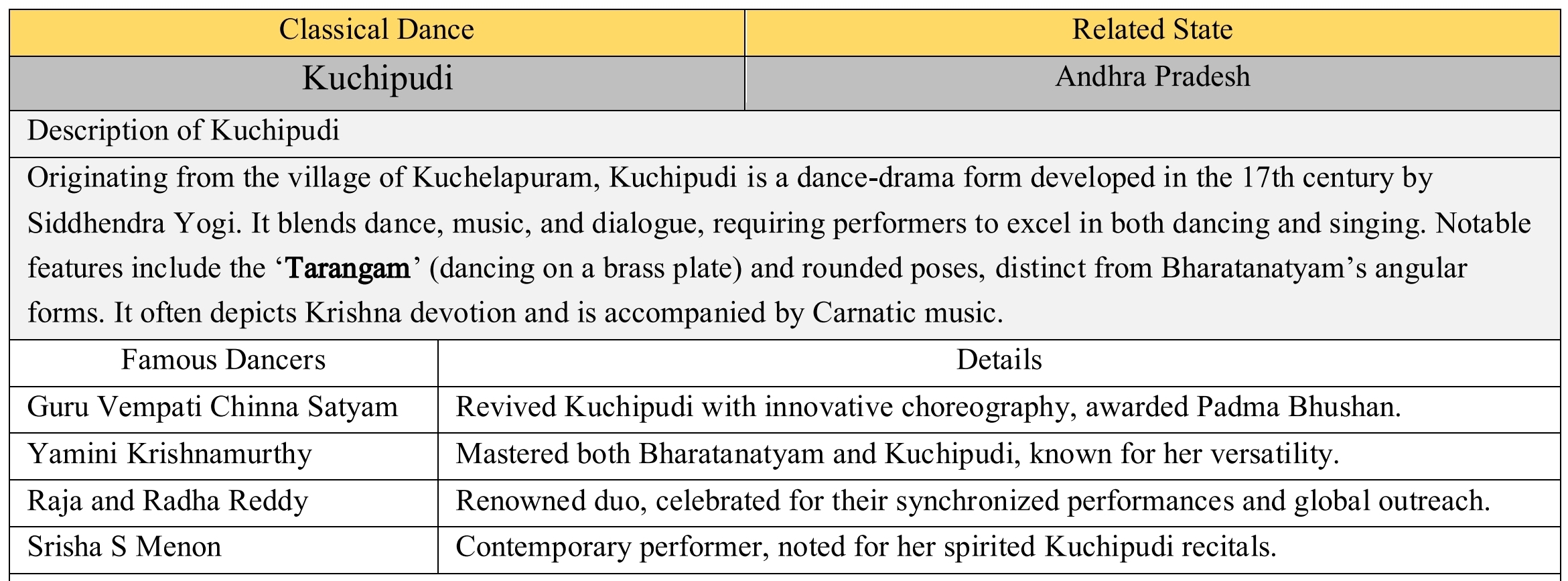
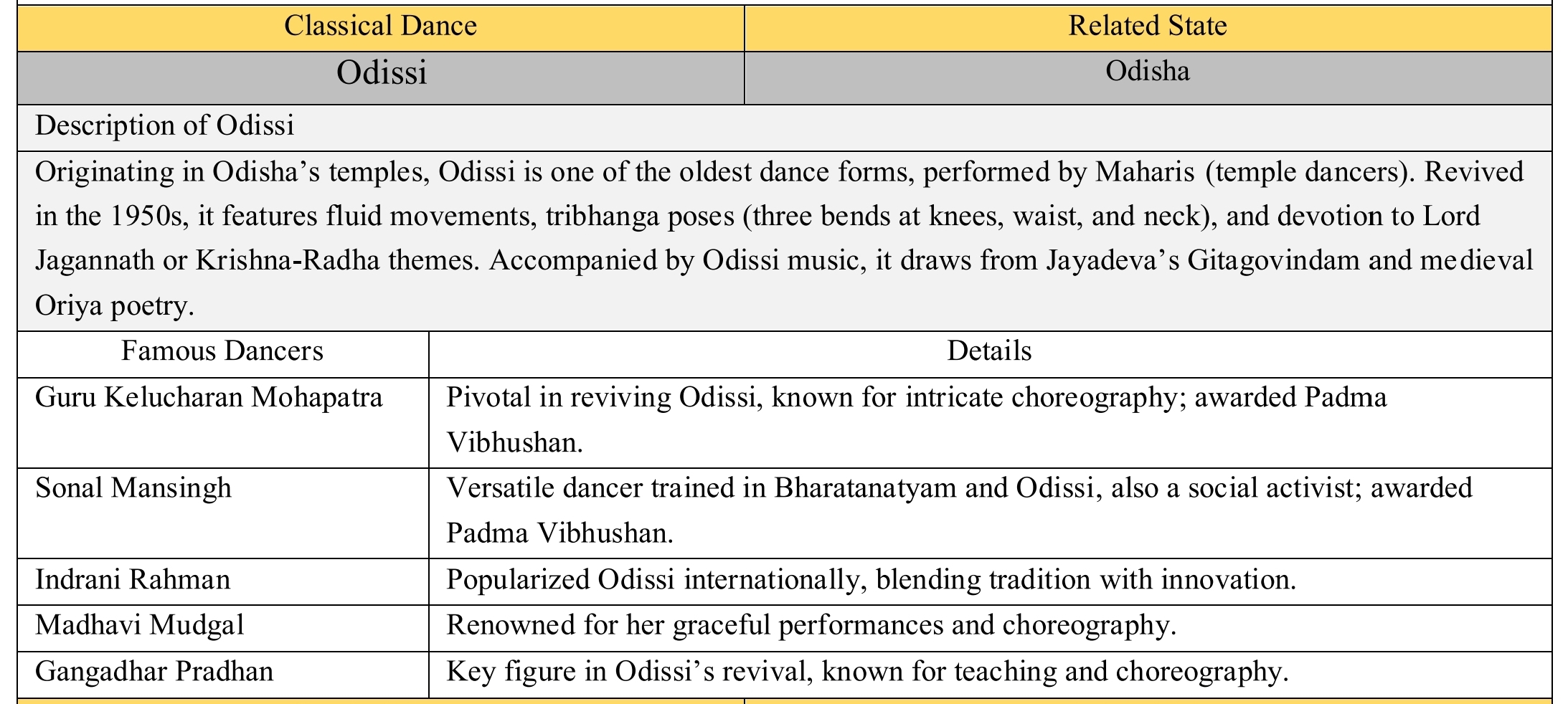
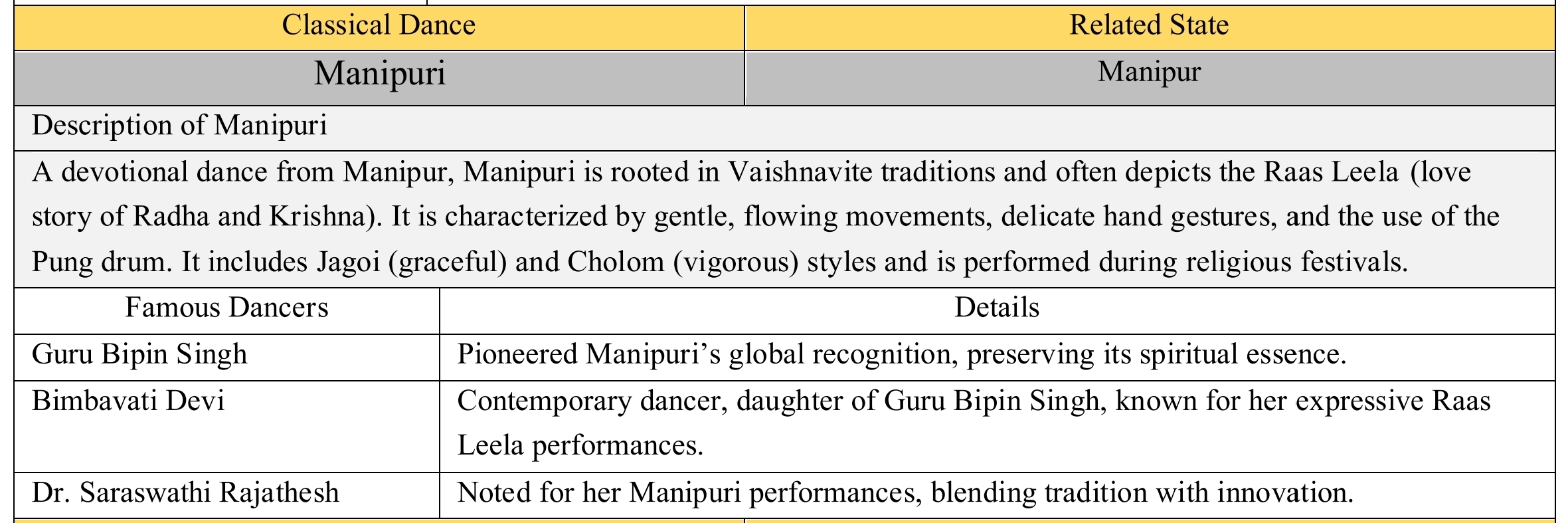
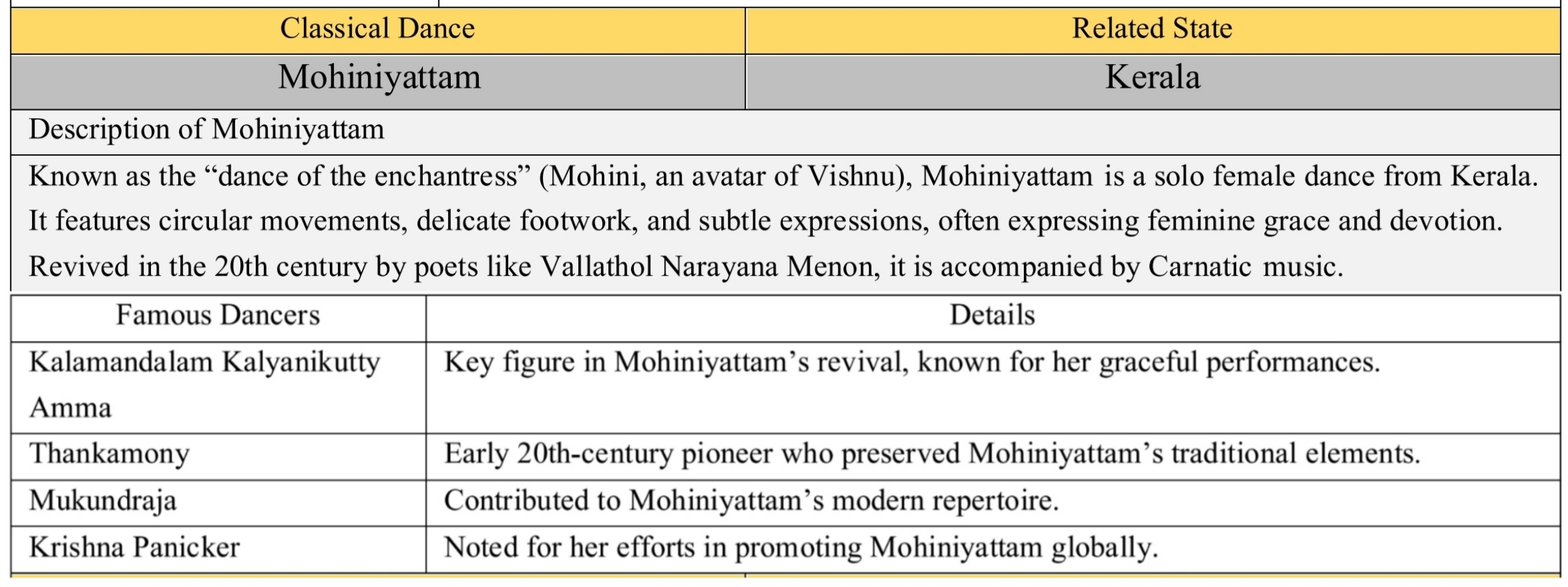
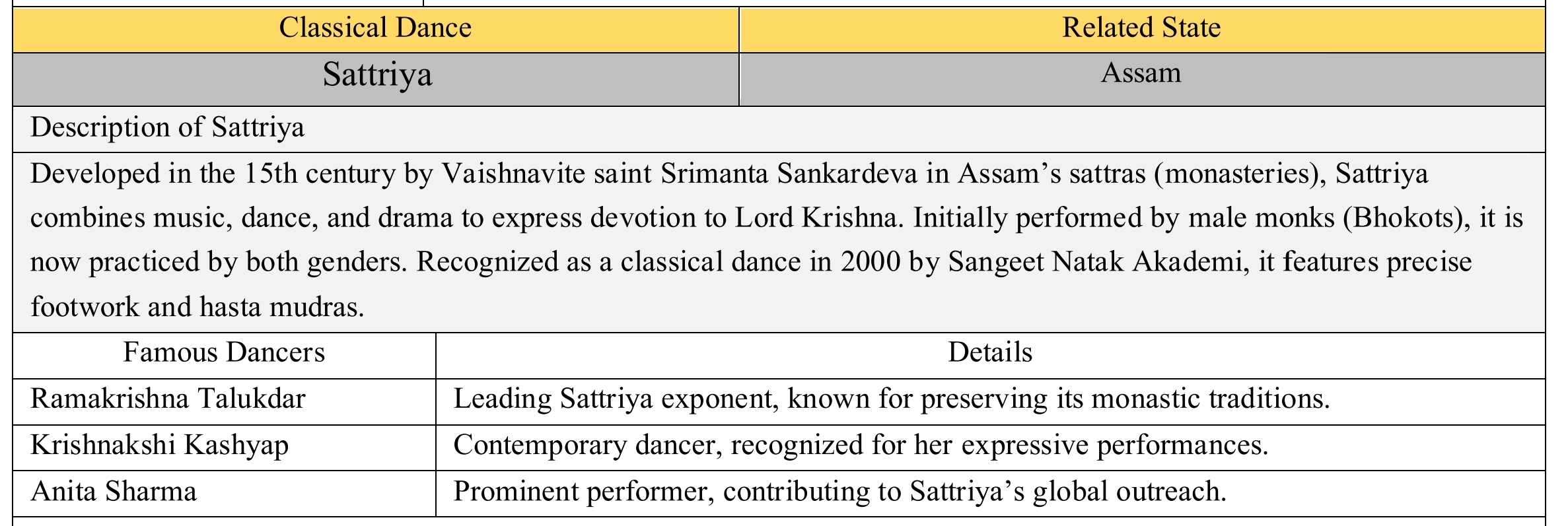
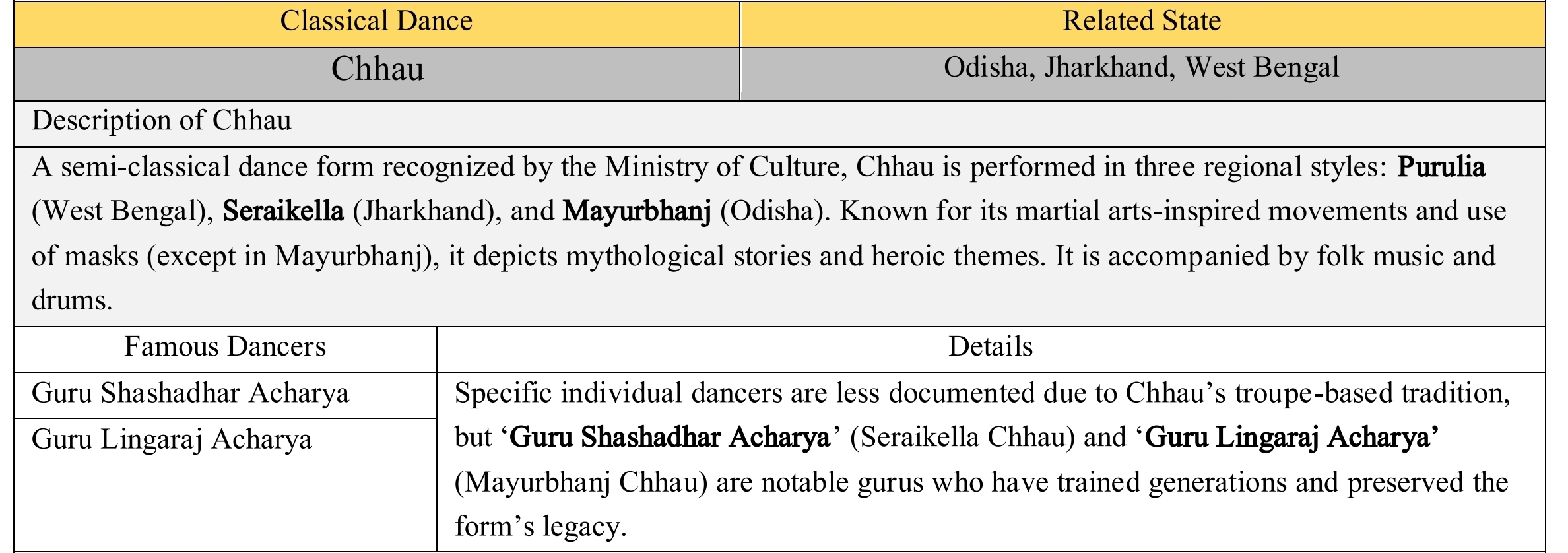
24. Match List-I with List-II and select the correct answer using the code given below the lists:
List-I
(Person)
List-II
(Well-known for)
A. Bhajan Sopori
1. Bharatnatyam dancer
B. Birju Maharaj
2. Exponent of Santoor
C. Priyadarsini Govind
3. Mridangam maestro
D. T.V.Gopalakrishnan
4. Kathak dancer
Code: A B C D
(a) 2 1 4 3
(b) 3 1 4 2
(c) 2 4 1 3
(d) 3 4 1 2
Correct Answer!
Incorrect Answer!
The correct answer is (c) 2 4 1 3
A. Bhajan Sopori – 2. Exponent of Santoor
Bhajan Sopori was a renowned Indian musician and composer, celebrated for his mastery of the santoor, a stringed musical instrument. He belonged to the Sopori family, known for their contributions to Indian classical music, particularly in the Sufiana gharana. This matches Exponent of Santoor.
B. Birju Maharaj – 4. Kathak dancer
Pandit Birju Maharaj was a legendary Kathak dancer and choreographer from the Lucknow Gharana. Known for his emotive storytelling, intricate footwork, and global promotion of Kathak, he received accolades like the Padma Vibhushan. This matches Kathak dancer.
C. Priyadarsini Govind – 1. Bharatanatyam dancer
Priyadarsini Govind is a distinguished Bharatanatyam dancer, known for her expressive performances and adherence to traditional techniques. She has been honored with awards like the Sangeet Natak Akademi Award for her contributions to this classical dance form. This matches Bharatanatyam dancer.
D. T.V. Gopalakrishnan – 3. Mridangam maestro
T.V. Gopalakrishnan is a celebrated Carnatic musician, renowned as a mridangam maestro and vocalist. He is also proficient in other instruments like the violin and has significantly contributed to South Indian classical music, earning awards like the Padma Bhushan. This matches Mridangam maestro.
Matching:
– A (Bhajan Sopori) → 2 (Exponent of Santoor)
– B (Birju Maharaj) → 4 (Kathak dancer)
– C (Priyadarsini Govind) → 1 (Bharatanatyam dancer)
– D (T.V. Gopalakrishnan) → 3 (Mridangam maestro)
Thus, the correct code is A B C D: 2 4 1 3, corresponding to option (c).
_
Correct Answer!
Incorrect Answer!
Tribhanga (meaning “three bends” in Sanskrit) is a classical pose in Indian dance and sculpture, characterized by the body being bent at three points: the knees, waist, and neck, with one leg bent and the body curved in opposite directions at the waist and neck. This creates an elegant, S-shaped posture, often seen in ancient Indian sculptures (e.g., in temples like Khajuraho or Konark) and classical dances like **Odissi*. It symbolizes grace and fluidity and has been a favorite of Indian artists from ancient times to the present. This description matches option (a).
Thus, (a) best describes the Tribhanga pose.
15. With reference to Dhrupad, one of the major traditions of India that has been kept alive for centuries, which of the following statements are correct?
1. Dhrupad originated and developed in the Rajput Kingdom period.
2. Dhrupad is primarily a devotional and spiritual music.
3. Dhrupad Alap uses Sanskrit syllables from Mantras.
Select the correct answer using the codes below:
Statement 1: Dhrupad originated and developed in the Rajput Kingdom period.
Dhrupad, one of the oldest forms of Hindustani classical music, is believed to have originated in the medieval period, particularly during the 15th–16th centuries, under the patronage of rulers like Raja Man Singh Tomar of Gwalior, not specifically during the Rajput Kingdom period (which is a broader and earlier historical context). It was formalized in the courts of Gwalior and later flourished under Mughal patronage. The statement is misleading and not entirely accurate, as Dhrupad’s development is more closely tied to the Bhakti movement and courtly traditions than the Rajput Kingdom period alone. This statement is incorrect.Statement 2: Dhrupad is primarily a devotional and spiritual music.
Dhrupad is deeply rooted in devotional and spiritual themes, often performed in praise of deities like Lord Krishna, Shiva, or other divine figures. Its compositions, known as dhrupads, frequently draw from Bhakti and spiritual traditions, and it was historically performed in temples and courts to evoke a meditative and divine experience. This statement is correct.Statement 3: Dhrupad Alap uses Sanskrit syllables from Mantras.
In Dhrupad, the Alap (the introductory, non-rhythmic portion of the performance) often uses syllables like “re, na, ta, ri” derived from Sanskrit mantras or Vedic chants. These syllables, known as nom-tom, are sung in a free-flowing, meditative style to explore the raga’s essence. This practice is a distinctive feature of Dhrupad, setting it apart from other classical music forms like Khayal. This statement is correct.Thus, only statements 2 and 3 are correct, making option (b) the right answer.
16. How do you distinguish between Kuchipudi and Bharatanatyam dances?
1. Dancers occasionally speaking dialogues is found in Kuchipudi dance but not in Bharatanatyam.
2. Dancing on the brass plate by keeping the feet on its edges is a feature of Bharatanatyam but Kuchipudi dance does not have such a form of movements.
Which of the statements given above is/are Correct?
Statement 1: Dancers occasionally speaking dialogues is found in Kuchipudi dance but not in Bharatanatyam. Kuchipudi, a classical dance form from Andhra Pradesh, is known for its dance-drama tradition, where dancers may occasionally speak dialogues or sing as part of the performance, especially in narrative pieces derived from its historical roots in Natya (theatrical storytelling). Bharatanatyam, originating from Tamil Nadu, focuses on pure dance (nritta) and expressive gestures (nritya) without spoken dialogues, relying on facial expressions and mudras to convey the narrative. This distinction is accurate, making this statement correct.
Statement 2: Dancing on the brass plate by keeping the feet on its edges is a feature of Bharatanatyam but Kuchipudi dance does not have such a form of movements. Dancing on a brass plate (known as *Tarangam) is a unique feature of **Kuchipudi, not Bharatanatyam. In Kuchipudi, dancers demonstrate their skill by balancing on the edges of a brass plate while performing intricate footwork, often accompanied by rhythmic patterns. Bharatanatyam does not include this practice, focusing instead on precise footwork and postures on the floor. The statement incorrectly attributes this feature to Bharatanatyam, making it incorrect.
Thus, only Statement 1 is correct, making option (a) the right answer.
| Dance | Related State | Description |
|---|---|---|
| Bharatanatyam | Tamil Nadu | A traditional South Indian dance form known for its intricate footwork, graceful expressions (abhinaya), and devotional storytelling often based on Hindu epics and temple traditions. |
| Kathak | Uttar Pradesh | A North Indian classical dance characterized by swift spins (chakkars), rhythmic foot movements, and expressive storytelling (katha) rooted in Mughal and Bhakti traditions. |
| Kathakali | Kerala | A dramatic classical dance-theatre featuring elaborate face makeup, ornate costumes, and storytelling through symbolic hand gestures (mudras) and facial expressions (rasas), often portraying mythological tales. |
| Kuchipudi | Andhra Pradesh | A dance-drama style combining pure dance (Nritta), expressional dance (Nritya), and dramatic representation (Natya), often involving character portrayal and use of dialogues or songs. |
| Odissi | Odisha | Known for its lyrical grace, tribhanga posture, and devotional mood, Odissi often narrates stories of Lord Jagannath, showcasing temple sculpture-like poses and smooth body movements. |
| Sattriya | Assam | A monastic dance rooted in the Vaishnavite traditions of Assam, developed by Srimanta Sankardev; performed in satras with a focus on devotion, spirituality, and bhakti rasa. |
| Manipuri | Manipur | A serene and devotional dance form linked to the Raas Leela of Krishna and Radha, marked by flowing costumes, gentle hand movements, and spiritual storytelling. |
| Mohiniyattam | Kerala | Graceful solo dance form associated with the feminine aspect of divinity (Mohini), noted for its swaying movements, soft expressions, and emotive storytelling based on love and devotion. |
| Chhau | West Bengal, Jharkhand, Odisha | A martial-based semi-classical dance blending folk, tribal, and classical elements; features acrobatic movements, masked performances, and themes from epics and folk traditions. |
17. The brothers Umakant and Ramakant Gundecha are:
Correct Answer!
Incorrect Answer!
The Gundecha Brothers, Umakant and Ramakant Gundecha, are renowned Dhrupad vocalists from Madhya Pradesh, India. They are celebrated for their mastery of Dhrupad, one of the oldest forms of Hindustani classical music, characterized by its devotional and meditative style. They have significantly contributed to preserving and promoting this ancient tradition through performances and teaching at the Dhrupad Sansthan in Bhopal.
Thus, (a) correctly identifies the Gundecha Brothers as Dhrupad vocalists.
18. Consider the following famous name:
1. Amrita Sher-Gil
2. Bikash Bhattaeharjee
3. N. S. Bendre
4. Subodh Gupta
Who of the above is/are-well known as artist (s)?
All four individuals listed are well-known artists from India, each contributing significantly to the field of visual arts in different styles and periods.
1. Amrita Sher-Gil: A pioneering modernist painter of the early 20th century, often called India’s Frida Kahlo. She is renowned for her vibrant portraits and paintings blending Indian and Western styles, such as *Three Girls and Village Scene. She is widely recognized as one of India’s most celebrated artists. Correct.
2. Bikash Bhattacharjee: A prominent Indian painter known for his surrealist and realist works, particularly his evocative portraits and socio-political commentaries. His paintings, like Doll Series and Durga, reflect deep emotional and societal themes. He is a well-known artist. Correct.
3. N. S. Bendre: A distinguished modernist artist and a key figure in the Progressive Artists’ Group. His works, characterized by vibrant colors and abstract forms, include landscapes and figurative paintings. He played a significant role in shaping modern Indian art. Correct.
4. Subodh Gupta: A contemporary Indian artist famous for his large-scale installations and sculptures using everyday objects like stainless steel utensils, reflecting Indian culture and globalization. Works like Very Hungry God have earned him international acclaim. He is a well-known artist. Correct.
Thus, all four—Amrita Sher-Gil, Bikash Bhattacharjee, N. S. Bendre, and Subodh Gupta—are well-known as artists, making option (d) the correct answer.
19. Consider the following statements:
1. The National School of Drama was set up by Sangeet Natak akademi in 1959.
2. The highest honour conferred by the Sahitya akademi on a writer is by electing him its Fellow.
Which of the statements given above is/are correct?
Statement 1: The National School of Drama was set up by Sangeet Natak Akademi in 1959. The National School of Drama (NSD) was established in 1959 under the aegis of the Sangeet Natak Akademi, India’s national academy for music, dance, and drama. It was set up to promote and train professionals in theater and dramatic arts and became an autonomous institution in 1975. This statement is correct.
Statement 2: The highest honour conferred by the Sahitya Akademi on a writer is by electing him its Fellow.* The Sahitya Akademi, India’s national academy of letters, confers its highest honor, the Sahitya Akademi Fellowship, on distinguished writers for their outstanding contributions to literature. This is considered more prestigious than the Sahitya Akademi Award, as it recognizes lifetime achievement and is limited to a small number of living fellows at any time. This statement is correct.
Thus, both statements 1 and 2 are correct, making option (c) the right answer.
20. Match List I with List II and select the correct answer using the code given below the lists:
List-I
(Famous Person)
|
List-II
(Well-known for)
|
|---|---|
| A. Mandakini Amte | 1. Theatre direction |
| B. Neelam Mansingh Chowdhry | 2. Social Service and Community leadership |
| C. Romila Thaper | 3. Dance |
| D. Vanashree Rao | 4. History writing |
Code: A B C D
Correct Answer!
Incorrect Answer!
A. Mandakini Amte – 2. Social Service and Community Leadership
Mandakini Amte, along with her husband Prakash Amte, is renowned for her social service and community leadership, particularly through their work at Lok Biradari Prakalp in Maharashtra. They have dedicated their lives to providing healthcare, education, and sustainable development to tribal communities in Gadchiroli, earning accolades like the Magsaysay Award. This matches Social Service and Community Leadership. (www.data.gov.in)
B. Neelam Mansingh Chowdhry – 1. Theatre Direction
Neelam Mansingh Chowdhry is a celebrated theatre director based in Chandigarh, known for directing plays like Nagamandala, Hayavadana, and Kitchen Katha. She is a recipient of the Sangeet Natak Akademi Award (2003) and Padma Shri (2011) for her contributions to theatre. This matches Theatre Direction. (bharatpedia)
C. Romila Thapar – 4. History Writing
Romila Thapar is a distinguished Indian historian, acclaimed for her works on ancient Indian history, including books like A History of India and Asoka and the Decline of the Mauryas. Her scholarly contributions have made her a leading figure in history writing. This matches History Writing.
D. Vanashree Rao – 3. Dance
Vanashree Rao is a well-known exponent of Kuchipudi, a classical Indian dance form. She has performed extensively and is recognized for her artistry and choreography in this traditional dance style. This matches Dance.Matching:
Thus, the correct code is A B C D: 2 1 4 3, corresponding to option (a).
21. Consider the following pairs:
| Tradition | State |
|---|---|
| 1. Gatka, a traditional martial art: | Kerala |
| 2. Madhubani, a traditional painting: | Bihar |
| 3. Singhey Khababs Sindhu Darshan Festival: | Jammu & Kashmir |
Which of the pairs given above is/are correctly matched?
Correct Answer!
Incorrect Answer!
Pair 1: Gatka, a traditional martial art – Kerala
Gatka is a traditional Sikh martial art originating from Punjab, not Kerala. It involves the use of weapons like sticks and swords and is performed during festivals and cultural events. Kerala is known for its own martial art, Kalaripayattu. This pair is incorrect.Pair 2: Madhubani, a traditional painting – Bihar
Madhubani painting, also known as Mithila art, is a traditional folk art form from *Bihar, characterized by intricate geometric patterns and mythological themes, often painted with natural dyes. This pair is correct.Pair 3: Singhey Khababs Sindhu Darshan Festival – Jammu and Kashmir
The Singhey Khababs Sindhu Darshan Festival is celebrated in Jammu and Kashmir, particularly in Leh, Ladakh. It is a cultural festival held along the banks of the Indus (Sindhu) River, promoting unity and celebrating the river’s significance. This pair is correct.Thus, only Pairs 2 and 3 are correctly matched, making option (c) the right answer.
22. Match List I with List II and select the correct answer using the code given below the lists:
List-I
(Famous Person)
|
List-II
(Well-known for)
|
|---|---|
| A. Amrita Sher-Gil | 1. Dancer |
| B. Bhimsen Joshi | 2. Painter |
| C. Rukmini Devi Arundale | 3. Poet |
| D. Suryakant Tripati Nirala | 4. Singer |
Code: A B C D
Correct Answer!
Incorrect Answer!
A. Amrita Sher-Gil – 2. Painter
Amrita Sher-Gil (1913–1941) was a pioneering Indian modernist painter, often referred to as India’s Frida Kahlo. Her works, such as Three Girls and Village Scene, blend Indian themes with Western techniques, making her one of India’s most celebrated artists. This matches Painter.
B. Bhimsen Joshi – 4. Singer
Pandit Bhimsen Joshi (1922–2011) was a legendary Hindustani classical singer, renowned for his mastery of the Kirana Gharana. His powerful renditions of ragas and bhajans earned him the Bharat Ratna (2008). This matches Singer.
C. Rukmini Devi Arundale – 1. Dancer
Rukmini Devi Arundale (1904–1986) was a pioneering dancer and choreographer, credited with reviving and popularizing Bharatanatyam. She founded the Kalakshetra Foundation in Chennai to promote classical dance and arts. This matches Dancer.
D. Suryakant Tripathi Nirala – 3. Poet
Suryakant Tripathi Nirala (1896–1961) was a prominent Hindi poet, writer, and essayist of the Chhayavaad movement. His works, like Saroj Smriti and Ram Ki Shakti Puja, are celebrated for their lyrical and philosophical depth. This matches Poet.Matching:
Thus, the correct code is A B C D: 2 4 1 3, corresponding to option (b).
23. Bimbavati Devi is a well-known dancer of which type of dance?
Correct Answer!
Incorrect Answer!
Bimbavati Devi is a renowned dancer and choreographer known for her expertise in Manipuri dance, a classical dance form from Manipur, India. She is the daughter of Guru Bipin Singh and Guru Kalavati Devi, both legendary figures in Manipuri dance. Bimbavati has contributed significantly to preserving and promoting this graceful and devotional dance form, characterized by fluid movements and Vaishnavite themes.
Thus, (a) Manipuri is the correct answer.









24. Match List-I with List-II and select the correct answer using the code given below the lists:
List-I
(Person)
|
List-II
(Well-known for)
|
|---|---|
| A. Bhajan Sopori | 1. Bharatnatyam dancer |
| B. Birju Maharaj | 2. Exponent of Santoor |
| C. Priyadarsini Govind | 3. Mridangam maestro |
| D. T.V.Gopalakrishnan | 4. Kathak dancer |
Code: A B C D
Correct Answer!
Incorrect Answer!
A. Bhajan Sopori – 2. Exponent of Santoor
Bhajan Sopori was a renowned Indian musician and composer, celebrated for his mastery of the santoor, a stringed musical instrument. He belonged to the Sopori family, known for their contributions to Indian classical music, particularly in the Sufiana gharana. This matches Exponent of Santoor.
B. Birju Maharaj – 4. Kathak dancer
Pandit Birju Maharaj was a legendary Kathak dancer and choreographer from the Lucknow Gharana. Known for his emotive storytelling, intricate footwork, and global promotion of Kathak, he received accolades like the Padma Vibhushan. This matches Kathak dancer.
C. Priyadarsini Govind – 1. Bharatanatyam dancer
Priyadarsini Govind is a distinguished Bharatanatyam dancer, known for her expressive performances and adherence to traditional techniques. She has been honored with awards like the Sangeet Natak Akademi Award for her contributions to this classical dance form. This matches Bharatanatyam dancer.
D. T.V. Gopalakrishnan – 3. Mridangam maestro
T.V. Gopalakrishnan is a celebrated Carnatic musician, renowned as a mridangam maestro and vocalist. He is also proficient in other instruments like the violin and has significantly contributed to South Indian classical music, earning awards like the Padma Bhushan. This matches Mridangam maestro.Matching:
Thus, the correct code is A B C D: 2 4 1 3, corresponding to option (c).
_
